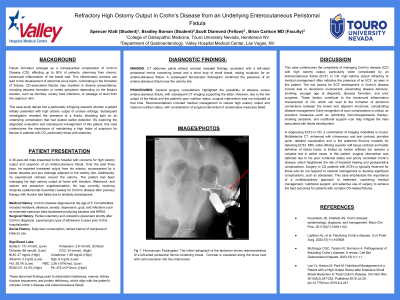Sunday Poster Session
Category: IBD
P0995 - Refractory High Ostomy Output in Crohn’s Disease From an Underlying Enterocutaneous Peristomal Fistula
Sunday, October 27, 2024
3:30 PM - 7:00 PM ET
Location: Exhibit Hall E

Has Audio

Spencer Klatt, MS
Touro University Nevada
Las Vegas, NV
Presenting Author(s)
Spencer Klatt, MS1, Bradley R. Boman, MS2, Scott Diamond, DO3, Brian Carlson, MD3
1Touro University Nevada, Las Vegas, NV; 2Touro University Nevada, Henderson, NV; 3Valley Hospital Medical Center, Las Vegas, NV
Introduction: High ostomy output, defined as exceeding 1.5 liters per day, is a common and significant complication for patients with bowel resection and can cause dehydration, electrolyte imbalances, and acute kidney injury. Causes of high ostomy output specifically in Crohn’s disease (CD) include active inflammation, short bowel syndrome, and complications such as fistula formation. Difficulties in managing chronic inflammation and surgical alterations in the GI tract make high ostomy output a particularly complex issue in CD patients.
Case Description/Methods: This patient is a 30 year-old male with CD, previous partial colectomy with a colostomy currently on an adalimumab biosimilar. He presented with recurrent high stool output from his ostomy and new purulent drainage into his colostomy bag. He had been taking Imodium, Metamucil, and electrolyte supplementation outpatient without response. A CT of the abdomen and pelvis without contrast and fistulogram confirmed a peristomal enterocutaneous fistula (ECF). Initial surgical intervention was deferred in lieu of better optimization of his CD.
Discussion: High ostomy output in Crohn’s disease refractory to medical management may indicate an ECF. Disease risk factors for ECF include ileal or ileocolonic disease and penetrating behavior. Other risk factors include smoking, younger age at diagnosis, abscesses, and prior surgeries. Early recognition allows proactive interventions to reduce fistula risks including optimizing immunosuppressive therapies, smoking cessation, and nutritional support. Optimal imaging for ECFs in Crohn's disease is a combination of CT and MRI. Multidetector CT, preferred for its quick and detailed imaging, is enhanced with intravenous and oral contrast. MRI offers superior soft tissue contrast, providing better definition of the fistula tract, despite being limited by motion artifacts. Surgery was deferred in this patient due to poor nutrition and poor control of his Crohn’s which would place the patient at risk for impaired healing and post-operative complications. Surgery is typically reserved for failure to respond to medical management or abscesses.
Disclosures:
Spencer Klatt, MS1, Bradley R. Boman, MS2, Scott Diamond, DO3, Brian Carlson, MD3. P0995 - Refractory High Ostomy Output in Crohn’s Disease From an Underlying Enterocutaneous Peristomal Fistula, ACG 2024 Annual Scientific Meeting Abstracts. Philadelphia, PA: American College of Gastroenterology.
1Touro University Nevada, Las Vegas, NV; 2Touro University Nevada, Henderson, NV; 3Valley Hospital Medical Center, Las Vegas, NV
Introduction: High ostomy output, defined as exceeding 1.5 liters per day, is a common and significant complication for patients with bowel resection and can cause dehydration, electrolyte imbalances, and acute kidney injury. Causes of high ostomy output specifically in Crohn’s disease (CD) include active inflammation, short bowel syndrome, and complications such as fistula formation. Difficulties in managing chronic inflammation and surgical alterations in the GI tract make high ostomy output a particularly complex issue in CD patients.
Case Description/Methods: This patient is a 30 year-old male with CD, previous partial colectomy with a colostomy currently on an adalimumab biosimilar. He presented with recurrent high stool output from his ostomy and new purulent drainage into his colostomy bag. He had been taking Imodium, Metamucil, and electrolyte supplementation outpatient without response. A CT of the abdomen and pelvis without contrast and fistulogram confirmed a peristomal enterocutaneous fistula (ECF). Initial surgical intervention was deferred in lieu of better optimization of his CD.
Discussion: High ostomy output in Crohn’s disease refractory to medical management may indicate an ECF. Disease risk factors for ECF include ileal or ileocolonic disease and penetrating behavior. Other risk factors include smoking, younger age at diagnosis, abscesses, and prior surgeries. Early recognition allows proactive interventions to reduce fistula risks including optimizing immunosuppressive therapies, smoking cessation, and nutritional support. Optimal imaging for ECFs in Crohn's disease is a combination of CT and MRI. Multidetector CT, preferred for its quick and detailed imaging, is enhanced with intravenous and oral contrast. MRI offers superior soft tissue contrast, providing better definition of the fistula tract, despite being limited by motion artifacts. Surgery was deferred in this patient due to poor nutrition and poor control of his Crohn’s which would place the patient at risk for impaired healing and post-operative complications. Surgery is typically reserved for failure to respond to medical management or abscesses.
Disclosures:
Spencer Klatt indicated no relevant financial relationships.
Bradley Boman indicated no relevant financial relationships.
Scott Diamond indicated no relevant financial relationships.
Brian Carlson indicated no relevant financial relationships.
Spencer Klatt, MS1, Bradley R. Boman, MS2, Scott Diamond, DO3, Brian Carlson, MD3. P0995 - Refractory High Ostomy Output in Crohn’s Disease From an Underlying Enterocutaneous Peristomal Fistula, ACG 2024 Annual Scientific Meeting Abstracts. Philadelphia, PA: American College of Gastroenterology.
